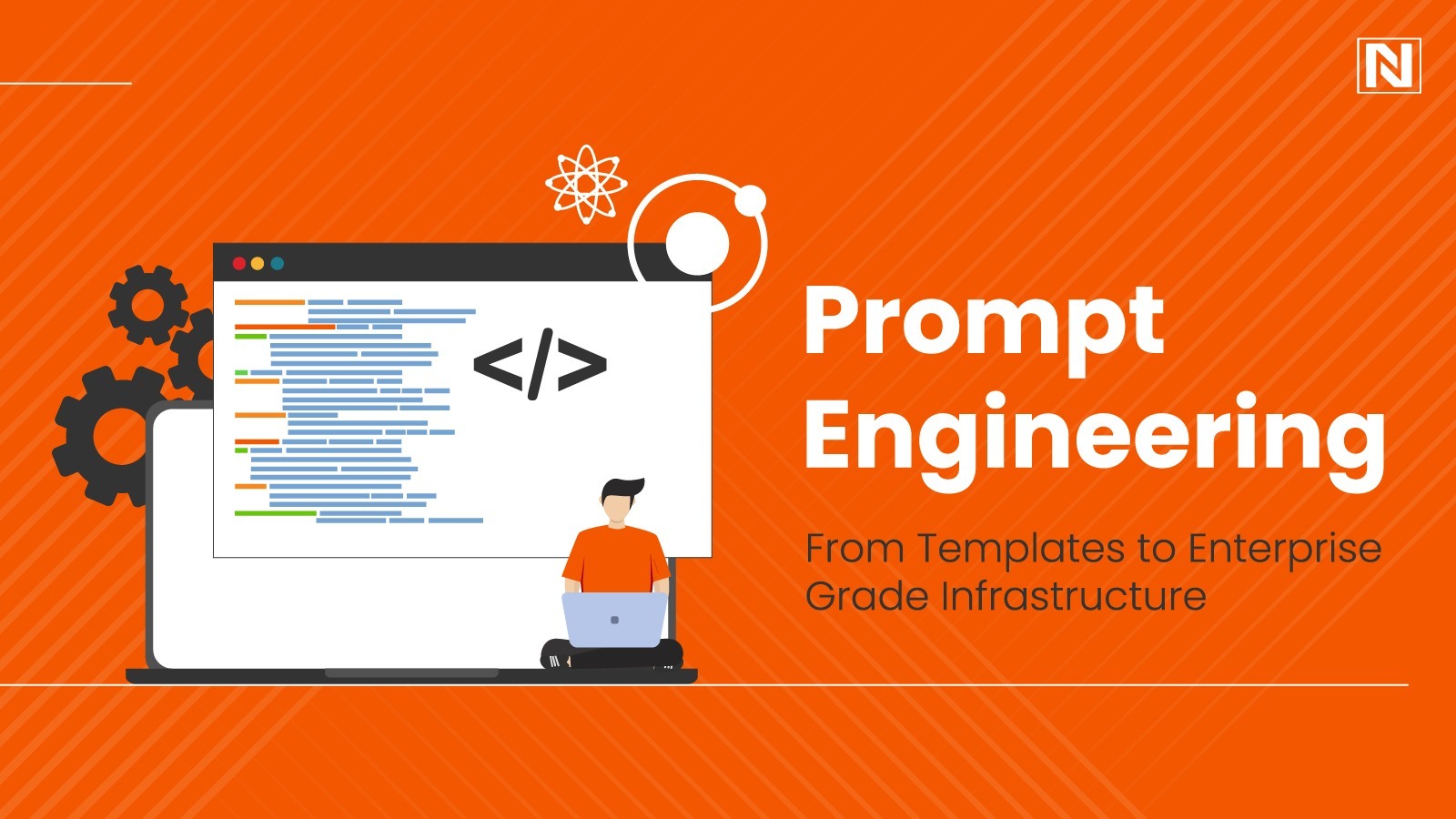
The conversation around prompt engineering has evolved quickly. What started as a handful of clever templates for coaxing better answers out of AI systems is now moving toward something far more serious: enterprise-grade infrastructure for managing, scaling, and governing prompts across business-critical use cases.
For decision-makers, this shift matters. The difference between treating prompts as one-off templates versus building a structured, repeatable, and governed infrastructure often determines whether AI projects deliver long-term business value or stall after experiments.
The Journey: From Templates to Infrastructure
At the start, most organizations test large language models (LLMs) with prompt templates. For example, a marketing team may keep a Google Doc of “best prompts” for ad copy. Or a customer service manager might share a few examples to help agents query an internal chatbot more effectively.
That approach works for pilots. But once you step into enterprise-wide adoption, the cracks show:
- Templates live in silos.
- There’s no version control or audit trail.
- Prompts break silently as models evolve.
- Reuse and standardization are nearly impossible.
This is why AI prompt templates vs enterprise infrastructure is not a small distinction. It’s the gap between hobby-level experimentation and production-grade deployment.
DID YOU KNOW?
The global prompt engineering market, valued at USD 222.1 million in 2023, is projected to expand to USD 2.06 billion by 2030, registering a CAGR of 32.8% between 2024 and 2030.
Why Enterprises Need Prompt Engineering as Structure
Think of prompt engineering as software engineering in disguise. Just like you wouldn’t run an ERP system on a handful of shared Excel sheets, you can’t scale AI with loose prompt templates.
When we talk about prompt engineering as enterprise grade structure, a few requirements stand out:

- Consistency: Standardized prompts across teams and regions.
- Governance: Versioning, approvals, and compliance tracking.
- Monitoring: Detecting drift when outputs degrade.
- Integration: Embedding prompts into workflows and applications, not copy-paste.
- Security: Guardrails to prevent sensitive data leakage.
What this really means is treating prompts not as text snippets, but as managed digital assets, part of a larger AI infrastructure.
Practical Examples of Enterprise Prompt Infrastructure
Let’s ground this in real scenarios.
1. Customer Support Automation
Instead of every support agent crafting prompts on the fly, enterprises deploy a central library of approved prompts. These integrate directly into the ticketing platform, ensuring consistent, safe responses across thousands of interactions.
2. Financial Reporting
Finance teams use structured prompts to query LLMs for summarizing quarterly data. With infrastructure in place, CFOs can trust that every query follows compliance rules and logs every interaction for audit purposes.
3. Healthcare Knowledge Assistants
Hospitals deploy prompt engineering infrastructure to ensure that doctors querying medical guidelines always use approved prompts with correct context, reducing the risk of errors or misinterpretation.
In each case, prompt templates alone would collapse under the weight of compliance, scale, and risk management. Infrastructure is what makes them enterprise-ready.
Comparing Templates vs Infrastructure
Here’s a quick side-by-side to illustrate the shift:
| Aspect | Prompt Templates | Enterprise Prompt Engineering Infrastructure |
| Storage | Docs, spreadsheets, chat threads | Centralized repository with version control |
| Usage | Copy-paste by individuals | API-driven integration into applications |
| Governance | None | Approval workflows, compliance checks |
| Scalability | Limited to small teams | Designed for thousands of users and use cases |
| Monitoring | Manual | Automated tracking of drift, quality, and ROI |
| Security | Informal | Role-based access, audit logs, data masking |
This isn’t about replacing creativity with bureaucracy. It’s about making sure that creativity scales safely and delivers measurable business outcomes.
Deployment Considerations: Building Prompt Engineering Infrastructure
If you’re considering prompt engineering infrastructure deployment, here’s how to approach it:
1. Start with Critical Use Cases
Not every team needs enterprise-grade infrastructure on day one. Identify high-impact areas (customer engagement, compliance-heavy workflows, or knowledge management) and start there.
2. Choose the Right Abstractions
Just as software engineers use frameworks, prompt engineers need libraries, modules, and patterns. Abstracting prompts into reusable, parameterized components is key.
3. Integrate with Existing Systems
Prompts must live inside the enterprise stack: CRM, ERP, analytics tools. APIs and connectors are non-negotiable. Avoid setups where users leave core systems to “go use AI.”
4. Implement Monitoring and Feedback
Business leaders care about outcomes, not just clever prompts. Build dashboards showing metrics like response accuracy, customer satisfaction, or time saved.
5. Govern Like Source Code
Adopt practices from DevOps: version control, testing, and rollback. Prompts should go through CI/CD-style pipelines before deployment.
The Business Outcomes That Matter
The temptation is to view prompt engineering as a technical detail. But for leadership, the question is: what business results does this deliver?
Enterprises that invest in structured infrastructure report outcomes like:

- Faster time-to-market: New AI features deploy in weeks, not months.
- Reduced risk: Compliance-ready workflows lower legal exposure.
- Cost efficiency: Centralized management cuts duplication and shadow IT.
- Higher trust: Employees adopt AI confidently when prompts are reliable and consistent.
In other words, structured prompt engineering is a driver of enterprise agility and competitiveness.
Lessons from Early Adopters
Several industries are already treating prompt engineering as infrastructure:
- Banking: Regulators demand auditable processes. Banks that centralize prompt management avoid costly compliance missteps.
- Retail: Global retailers utilize enterprise prompt libraries to localize product descriptions across markets, thereby reducing translation costs while maintaining brand consistency.
- Manufacturing: Engineering firms deploy prompts into IoT dashboards, allowing technicians to query machines in natural language with confidence.
The pattern is clear: early adopters don’t rely on templates, they build structured, governed systems.
Looking Ahead
As AI systems get more powerful, the cost of sloppy prompt practices rises. Enterprises that cling to templates will face fragmentation, risk, and wasted investment.
Those who treat prompt engineering as enterprise grade structure will unravel scale, resilience, and measurable ROI. The shift is the natural evolution of AI adoption.
Closing Thought
We’ve seen this movie before. In the early days of software, teams hacked together scripts and macros. Over time, the need for structure, governance, and scale created disciplines like DevOps and enterprise architecture.
Prompt engineering is on the same path. The organizations that recognize this shift and invest in infrastructure now will be the ones turning AI into a durable competitive advantage.
Frequently Asked Questions
What’s the difference between AI prompt templates and enterprise prompt engineering infrastructure?
Templates are static text snippets. Infrastructure is a governed, scalable system that manages, monitors, and deploys prompts across the enterprise.
Why do enterprises need prompt engineering infrastructure?
To ensure consistency, compliance, scalability, and measurable business outcomes across AI deployments.
How do you deploy prompt engineering infrastructure?
Start with high-impact use cases, centralize prompt management, integrate with core systems, and add monitoring plus governance.
What business outcomes can it deliver?
Faster deployment, lower compliance risk, cost savings, and higher trust in AI across teams.
Which industries benefit the most?
Highly regulated or large-scale industries like banking, healthcare, retail, and manufacturing see the biggest gains.
